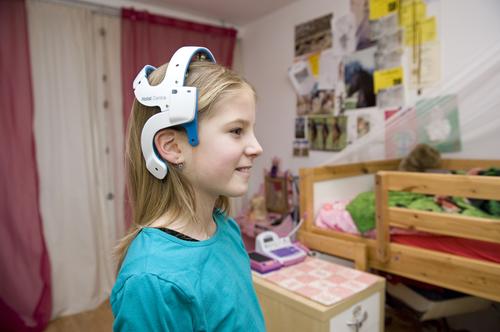Medical-Grade EEG Comes to Your Home
January 14, 2015

Belgium-based nanoelectronics company imec, in partnership with the Holst Centre for R&D research, has developed a wireless headset capable of bringing the same medical-grade Electroencephalography (EEG) seen in hospitals into the home.
The key lies in the headset's continuous monitoring technology. Taking a typical EEG can be a cumbersome and outright annoying process. Incorrectly mounting electrodes onto a subject or any kind of muscle activity — especially head and jaw movement — can impede the signal. Naturally, this leads to a lot of trial and error and wasted time, particularly with hyperactive patients, such as children, or those with motor or muscular issues.
Current EEG technology measures electrical electrode-to-skin impedance before the EEG recording using wet electrodes that use a gel for adhesion and to reduce skin impedance. The whole process can be a bit messy and also time-consuming in comparison to other imaging technologies, such as fMRI, as the electrodes are carefully adjusted until they all have a proper electrical contact to the skin.
By contrast, imec's EEG headset uses dry electrodes. Dry electrodes require no gel but are not as reliable as their wet counterparts and have a higher signal-to-noise ratio because of the increased impedance from direct contact with the skin. The challenge for dry electrodes is to overcome this and also account for the added impedance created by motion artefacts.
imec's headset resolves this issue with several mechanisms working together. The first is pre-amplification applied to the measurement position using what Bernard Grundlehner, imec's program manager for its wearable EEG, called “active electrodes” that are capable of measuring this electrical contact impedance continuously — even while the EEG is being measured, and without influencing the EEG signal. “These so-called ‘active electrodes’ prevent the wiring between the electrode and the main amplifier from picking up all sorts of electro-magnetic noise, including power line noise,” Grundlehner said.
Related articles on DesignNews.com
By using an adaptive filter in correlation with band-pass filtering, imec's headset can effectively create an EGG signal with any impedance caused by motion artifacts subtracted from it. “The correlation between the motion artefacts and the impedance signal is very high, and we have successfully used this impedance signal to reduce the amplitude of the motion artifacts in the EEG signal,” Grundlehner said.
Giving the headset wireless capabilities presented its own sets of issues. “We are using standard Bluetooth and Bluetooth low-energy radio technology, which when combined with a very sensitive EEG amplifier can be very challenging,” Grundlehner said. “The radiated radio frequency [RF] power can be easily picked up by the system resulting in noise spikes in the spectrum of the EEG signal.”
The solution was in meticulous design to ensure the circuit board layouts and connectors were laid out in a way to eliminate Bluetooth interference. “An additional benefit was that our system did not only become immune to its own Bluetooth radiation, but also to RF radiation from other sources such as the mobile phone, making it possible to check Facebook or receive phone calls while measuring EEG,” Grundlehner said.
imec is currently collaborating with partners across various industries who can bring the headset to market. Since the company offers the basic building blocks — including a miniaturized electronics module, firmware, and API’s for Android, iOS, Windows, and OS X — it is likely developers could find applications for the headset in various aspects of healthcare and also in areas of fitness and wellness and entertainment. A 2007 study showed neurofeedback from EEG can be comparable to drug treatments for ADHD and other studies have shown its effectiveness in reducing epileptic seizures. Imagine this sort of non-invasive treatment being adapted for home use.
Grundlehner said that while imec is moving forward with partnerships around the device, it is also continuing to iterate and improve it. “Our current focus goes out to improving the comfort of the system by using a new type of dry electrodes made of conductive rubber, and to miniaturizing the system even further. We are also developing new collaborations with hospitals to validate our system in various use case scenarios.”
Design engineers and professionals, the West Coast’s most important design, innovation, and manufacturing event, Pacific Design & Manufacturing, is taking place in Anaheim, Feb. 10-12, 2015. A Design News event, Pacific Design & Manufacturing is your chance to meet qualified suppliers, get hands-on access to the latest technologies, be informed from a world-class conference program, and expand your network. (You might even meet a Design News editor.) Learn more about Pacific Design & Manufacturing here.
About the Author(s)
You May Also Like



